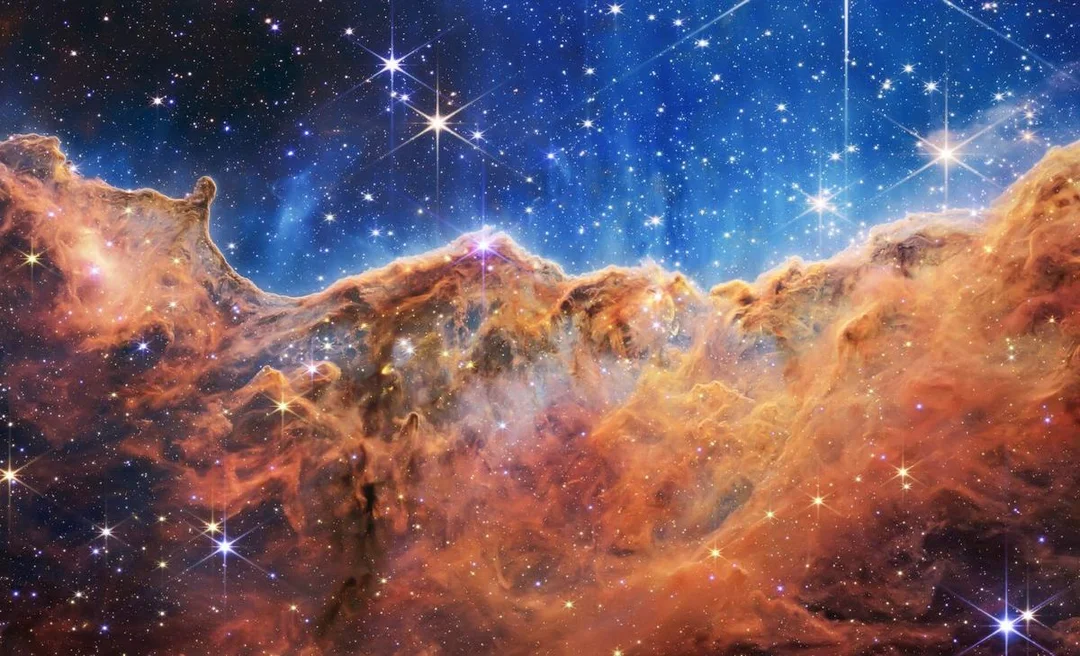
Dive into the ‘Cosmic Cliffs’: James Webb Telescope Image Transformed into Stunning 3D Experience
The iconic "Cosmic Cliffs" image captured by the James Webb Space Telescope (JWST) has been given a breathtaking new dimension. Originally revealed in July 2022, this stunning portrait of a star-forming region has been transformed into an immersive **3D** experience, allowing viewers to journey deep into a glittering star nursery.
This new visualization comes from NASA’s Universe of Learning program and premiered at a special event hosted by the International Planetarium Society in Munich, marking the centennial celebration of the first public planetarium. The 3D tour isn't just a visual spectacle; it's a powerful tool for understanding the complex structures within nebulae.

The original image showcased a jagged wall of gas and dust, resembling mountains illuminated by starlight. In reality, this "cliff" is part of the nebula Gum 31 within the larger Carina Nebula Complex. Hidden above the Webb frame lies the young star cluster NGC 3324. The intense ultraviolet radiation and fierce stellar winds from this cluster have carved out a vast cavity in the nebula, with the Cosmic Cliffs marking one edge of this cosmic bubble.
Webb's near-infrared vision captured the cliff as blue and gold wisps, dotted with emerging stars. The **3D** tour adds depth, creating a sense of soaring peaks and plunging valleys. Heated gas flows upward like mist across the ridge, while bright yellow arcs reveal jets erupting from infant suns as they tunnel through the cloud.
Frank Summers, visualization scientist at the Space Telescope Science Institute (STScI), emphasized the importance of this transformation: “Bringing this amazing Webb image to life helps the public to comprehend the three-dimensional structure inherent in the 2D image, and to develop a better mental model of the universe.”
This **3D** Cosmic Cliffs experience isn't just a standalone project; it’s part of a larger narrated video created by STScI in partnership with Caltech/IPAC. Designed for planetariums, museums, and classrooms, the full production connects the epic scene to the tools and methods that astronomers use to study stellar birth.
Gum 31, composed of hydrogen, helium, and cosmic dust, is located approximately 7,600 light-years away. The stars within NGC 3324 are only a few million years old, their radiation sculpting the surrounding cloud and giving rise to new stellar formation. Webb's infrared sensitivity reveals these hidden embryos, previously obscured by cooler dust.
The visualization process translates scientific data into a sculpted digital mesh. Color layers from Webb’s detectors are overlaid onto the mesh, and particle systems simulate drifting gas. Astrophysicists were consulted to ensure fidelity in distances, densities, and light scattering.
The James Webb Space Telescope continues to revolutionize our understanding of the cosmos. Since its launch in late 2021, it has studied exoplanet atmospheres, identified some of the earliest galaxies, and created detailed maps of star-forming regions. The Cosmic Cliffs image, a key part of Webb's initial public showcase, has become an icon, with this conversion deepening public engagement and highlighting Webb’s ability to uncover hidden structures.
Future plans include similar **3D** transformations of other Webb highlights. As technology progresses, future versions may allow users to navigate through nebulae using virtual reality headsets.
This **3D** journey through the Cosmic Cliffs offers more than just visual awe; it fosters an intuitive understanding of scale and process, transforming distant astrophysical events into an immersive and relatable experience.
What aspects of this **3D** visualization impressed you the most? Share your thoughts and insights in the comments below!